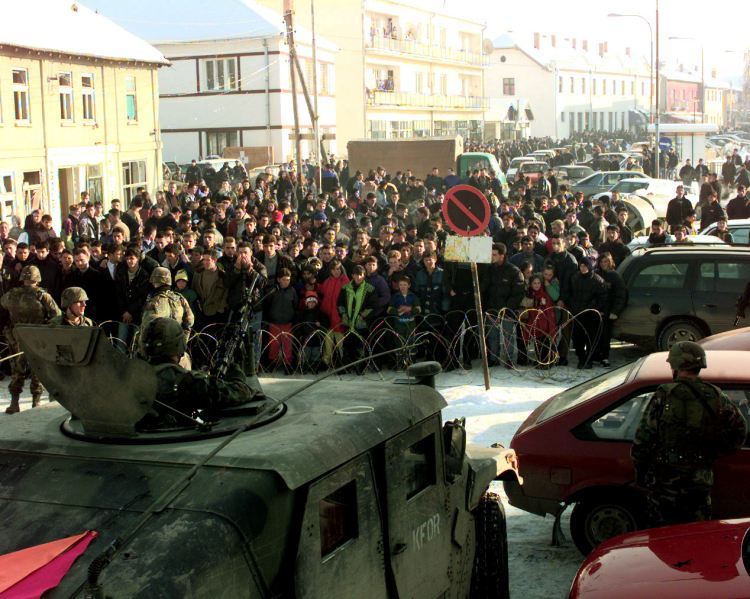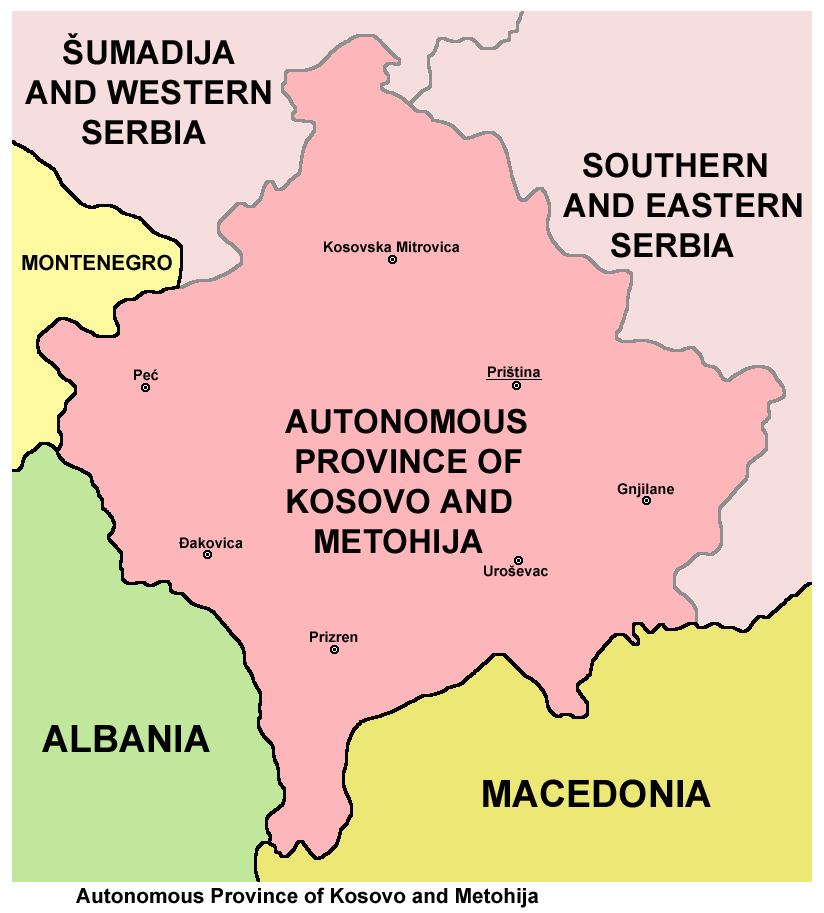|
Church Of The Holy Mother Of God, Podgorce
Church of the Holy Mother of God was a Serbian Orthodox Church located in the village of Podgorce, in the municipality of Vitina, in Kosovo and Metohija. It belonged to the Diocese of Raška and Prizren of the Serbian Orthodox Church. The church was rebuilt and consecrated in 1996. The destruction of the church in 1999 The church was looted and burned by Kosovo Albanians The Albanians of Kosovo ( sq, Shqiptarët e Kosovës, ), also commonly called Kosovo Albanians, Kosovar/Kosovan Albanians or Kosovars/Kosovans, constitute the largest ethnic group in Kosovo. Kosovo Albanians belong to the ethnic Albanian sub- ... after the arrival of the US KFOR troops. References External links The list of destroyed and desecrated churches in Kosovo and Metohija June-October 1999 (Списак уништених и оскрнављених цркава на Косову и Метохији јун-октобар 1999) {{DEFAULTSORT:Church of the Holy Mother of God, Podgorce ... [...More Info...] [...Related Items...] OR: [Wikipedia] [Google] [Baidu] |
Kosovo
Kosovo ( sq, Kosova or ; sr-Cyrl, Косово ), officially the Republic of Kosovo ( sq, Republika e Kosovës, links=no; sr, Република Косово, Republika Kosovo, links=no), is a partially recognised state in Southeast Europe. It lies at the centre of the Balkans. Kosovo unilaterally declared its independence from Serbia on 17 February 2008, and has since gained diplomatic recognition as a sovereign state by 101 member states of the United Nations. It is bordered by Serbia to the north and east, North Macedonia to the southeast, Albania to the southwest, and Montenegro to the west. Most of central Kosovo is dominated by the vast plains and fields of Dukagjini and Kosovo field. The Accursed Mountains and Šar Mountains rise in the southwest and southeast, respectively. Its capital and largest city is Pristina. In classical antiquity, the central tribe which emerged in the territory of Kosovo were Dardani, who formed an independent polity known as the ... [...More Info...] [...Related Items...] OR: [Wikipedia] [Google] [Baidu] |
Serbian Orthodox
The Serbian Orthodox Church ( sr-Cyrl, Српска православна црква, Srpska pravoslavna crkva) is one of the autocephalous (ecclesiastically independent) Eastern Orthodox Christian churches. The majority of the population in Serbia, Montenegro and the Republika Srpska entity of Bosnia and Herzegovina are members of the Serbian Orthodox Church. It is organized into metropolitanates and eparchies, located primarily in Serbia, Bosnia and Herzegovina, Montenegro, and Croatia. Other congregations are located in the Serb diaspora. The Serbian Patriarch serves as first among equals in his church. The current patriarch is Porfirije, enthroned on 19 February 2021. The Church achieved autocephalous status in 1219, under the leadership of Saint Sava, becoming the independent Archbishopric of Žiča. Its status was elevated to that of a patriarchate in 1346, and was known afterwards as the Serbian Patriarchate of Peć. This patriarchate was abolished by the Ottoman ... [...More Info...] [...Related Items...] OR: [Wikipedia] [Google] [Baidu] |
Serbian Orthodox Church
The Serbian Orthodox Church ( sr-Cyrl, Српска православна црква, Srpska pravoslavna crkva) is one of the autocephalous ( ecclesiastically independent) Eastern Orthodox Christian churches. The majority of the population in Serbia, Montenegro and the Republika Srpska entity of Bosnia and Herzegovina are members of the Serbian Orthodox Church. It is organized into metropolitanates and eparchies, located primarily in Serbia, Bosnia and Herzegovina, Montenegro, and Croatia. Other congregations are located in the Serb diaspora. The Serbian Patriarch serves as first among equals in his church. The current patriarch is Porfirije, enthroned on 19 February 2021. The Church achieved autocephalous status in 1219, under the leadership of Saint Sava, becoming the independent Archbishopric of Žiča. Its status was elevated to that of a patriarchate in 1346, and was known afterwards as the Serbian Patriarchate of Peć. This patriarchate was abolished by th ... [...More Info...] [...Related Items...] OR: [Wikipedia] [Google] [Baidu] |
Vitina (town)
Viti ( sq-definite, Vitia) or Vitina ( sr-Cyrl, Витина), is a town and municipality located in the District of Gjilan in Kosovo. According to the 2011 census, the town of Viti has 4,924 inhabitants, while the municipality has 46,987 inhabitants. Municipality * Ballancë/Balance * Beguncë/Begunce * Binça/Binač * Budrikë e Epërme/Gornja Budrika * Buzovik * Çifllak/Čiflak * Dëbëlldeh/ Debelde * Devajë/Devaja * Drobesh/Drobeš * Gërmovë/Grmovo * Gjylekar/ Đelekare * Goden i Madh/Veliki Goden * Gushicë/Gušica * Kabash/Kabaš * Letnicë/Letnica * Lubishtë/ Ljubište * Mjak/Mijak * Novosellë/Novo Selo * Podgorc/Podgorce * Pozharan/Požaranje * Radivojc/Radivojce * Ramjan/Donje Ramnjane * Ramnishtë/Ravnište * Remnik/Ribnik * Sadovinë e Çerkezëve/Čerkez Sadovina * Sadovinë e Jerlive/Jerli Sadovina * Shasharë/Šašare * Sllatinë e Epërme/Gornja Slatina * Sllatinë e Poshtme/Donja Slatina * Smirë/ Smira * Stubëll e Epërme/Gornja Stubla * Stubëll e ... [...More Info...] [...Related Items...] OR: [Wikipedia] [Google] [Baidu] |
Kosovo And Metohija
The Autonomous Province of Kosovo and Metohija ( sr, Косово и Метохиja, Kosovo i Metohija; sq, Kosova dhe Metohija), commonly known as Kosovo and abbreviated to Kosmet or KiM, is an autonomous province defined by the constitution of Serbia that occupies the southernmost part of Serbia. The territory is the subject of an ongoing political and territorial dispute between Serbia and the partially recognised, self-proclaimed Republic of Kosovo, the latter of which has control over the region. Its claimed administrative capital and largest city is Pristina. The territory of the province, as recognized by Serbian laws, lies in the southern part of Serbia and covers the regions of Kosovo and Metohija. The capital of the province is Pristina. The territory was previously an autonomous province of Serbia during Socialist Yugoslavia (1946–1990), and acquired its current status in 1990. The province was governed as part of Serbia until the Kosovo War (1998–99), ... [...More Info...] [...Related Items...] OR: [Wikipedia] [Google] [Baidu] |
Diocese Of Raška And Prizren
In church governance, a diocese or bishopric is the ecclesiastical district under the jurisdiction of a bishop. History In the later organization of the Roman Empire, the increasingly subdivided provinces were administratively associated in a larger unit, the diocese (Latin ''dioecesis'', from the Greek term διοίκησις, meaning "administration"). Christianity was given legal status in 313 with the Edict of Milan. Churches began to organize themselves into dioceses based on the civil dioceses, not on the larger regional imperial districts. These dioceses were often smaller than the provinces. Christianity was declared the Empire's official religion by Theodosius I in 380. Constantine I in 318 gave litigants the right to have court cases transferred from the civil courts to the bishops. This situation must have hardly survived Julian, 361–363. Episcopal courts are not heard of again in the East until 398 and in the West in 408. The quality of these courts was lo ... [...More Info...] [...Related Items...] OR: [Wikipedia] [Google] [Baidu] |
Kosovo Albanians
The Albanians of Kosovo ( sq, Shqiptarët e Kosovës, ), also commonly called Kosovo Albanians, Kosovar/Kosovan Albanians or Kosovars/Kosovans, constitute the largest ethnic group in Kosovo. Kosovo Albanians belong to the ethnic Albanian sub-group of Ghegs, who inhabit the north of Albania, north of the Shkumbin river, Kosovo, southern Serbia, and western parts of North Macedonia. They speak Gheg Albanian, more specifically the Northwestern and Northeastern Gheg variants. According to the 1991 Yugoslav census, boycotted by Albanians, there were 1,596,072 ethnic Albanians in Kosovo or 81.6% of population. By the estimation in the year 2000, there were between 1,584,000 and 1,733,600 Albanians in Kosovo or 88% of population; as of 2011, their population share is 92.93%. History Pre-7th century Toponymical evidence suggests that Albanian was spoken in western and eastern Kosovo and the Niš region before the Migration Period. In this era, Albanian in Kosovo was in l ... [...More Info...] [...Related Items...] OR: [Wikipedia] [Google] [Baidu] |
Kosovo Force
The Kosovo Force (KFOR) is a NATO-led international peacekeeping force in Kosovo. Its operations are gradually reducing until Kosovo's Security Force, established in 2009, becomes self sufficient. KFOR entered Kosovo on 11 June 1999, two days after the adoption of UN Security Council Resolution 1244. At the time, Kosovo was facing a grave humanitarian crisis, with military forces from Yugoslavia in action against the Kosovo Liberation Army (KLA) in daily engagements. Nearly one million people had fled Kosovo as refugees by that time, and many did not permanently return. KFOR is gradually transferring responsibilities to the Kosovo Police and other local authorities. Currently, 28 states contribute to the KFOR, with a combined strength of approximately 4,000 military and civilian personnel. The mission was initially called Operation Joint Guardian. In 2004, the codename for the mission was changed to Operation Joint Enterprise. Objectives KFOR focuses on building a secure ... [...More Info...] [...Related Items...] OR: [Wikipedia] [Google] [Baidu] |
Serbian Orthodox Church Buildings In Kosovo
Serbian may refer to: * someone or something related to Serbia, a country in Southeastern Europe * someone or something related to the Serbs, a South Slavic people * Serbian language * Serbian names See also * * * Old Serbian (other) * Serbians * Serbia (other) * Names of the Serbs and Serbia Names of the Serbs and Serbia are terms and other designations referring to general terminology and nomenclature on the Serbs ( sr, Срби, Srbi, ) and Serbia ( sr, Србија/Srbija, ). Throughout history, various endonyms and exonyms have ... {{Disambiguation Language and nationality disambiguation pages ... [...More Info...] [...Related Items...] OR: [Wikipedia] [Google] [Baidu] |
Destroyed Churches In Kosovo
Destroyed may refer to: * ''Destroyed'' (Sloppy Seconds album), a 1989 album by Sloppy Seconds * ''Destroyed'' (Moby album), a 2011 album by Moby See also * Destruction (other) * Ruined (other) * {{disambiguation ... [...More Info...] [...Related Items...] OR: [Wikipedia] [Google] [Baidu] |
Former Serbian Orthodox Churches
A former is an object, such as a template, gauge or cutting die, which is used to form something such as a boat's hull. Typically, a former gives shape to a structure that may have complex curvature. A former may become an integral part of the finished structure, as in an aircraft fuselage, or it may be removable, being using in the construction process and then discarded or re-used. Aircraft formers Formers are used in the construction of aircraft fuselage, of which a typical fuselage has a series from the nose to the empennage, typically perpendicular to the longitudinal axis of the aircraft. The primary purpose of formers is to establish the shape of the fuselage and reduce the column length of stringers to prevent instability. Formers are typically attached to longerons, which support the skin of the aircraft. The "former-and-longeron" technique (also called stations and stringers) was adopted from boat construction, and was typical of light aircraft built until the a ... [...More Info...] [...Related Items...] OR: [Wikipedia] [Google] [Baidu] |

.jpg)




